
Quaint small towns always tug at my heart. Born in the developing world, I vividly remember the simple, laid-back, and old-fashioned life before the crowded tech-infused cities and corporate jungles I eventually thrived in. To get to know Alaska, it’s not enough to explore just Anchorage and Fairbanks, Alaska’s two big cities. To really get to know this last American frontier, one must experience its smaller and more remote towns.
Videos by TravelAwaits
On two road trips going north from Anchorage to Fairbanks, we discovered four such towns; and the Alaska-Canada border also presented us with two others. These are the six that paint the inviting frontier picture of Alaska north of Anchorage; in this subsequent article, I write about 6 Charming Small Towns To Visit In Southern Alaska.

1. Talkeetna
Dubbed the coolest of cool towns in America, Talkeetna is situated near the base of Mt. McKinley, the highest mountain in North America. Located in the Matanuska-Susitna Borough with an estimated population of less than 1,000, it is also at the confluence of three rivers: Talkeetna, Chulitna, and Susitna. You might say that its location alone makes it an impeccably attractive destination. In summer, it is only a 3-hour train ride north of Anchorage.
We discovered the town when we got hungry and looked for a place to eat on the way back to Anchorage after visiting Denali National Park and being disappointed that cloudy McKinley was again in hiding. There are supposedly three great places to view the “High One”: Denali South (Mile 135), Denali North (Mile 163), and Wonder Lake (inside Denali National Park). The restaurant at Mt. McKinley View Lodge, just half a mile before Denali South right on George Parks Highway, had the best views of the venerable mountain.
Talkeetna is also a popular staging point for as many as 1,000 climbers who come to conquer McKinley every year. Even flightseeing tours and glacier landings originate from the Talkeetna Airport and not Denali National Park. The many rustic miners’ cabins renovated as lodging, restaurants, and shops are part of the town’s rich history. Finally, the three rivers offer best-of-Alaska rafting, boating, and sports fishing.
Pro Tip: During summer, Talkeetna is a beehive of activities: outdoor markets, live music concerts, and other activities offered at the Talkeetna Ranger Station. And, during winter, you have a good chance of seeing the Northern Lights here.

2. Healy
Less than 3 hours north of Talkeetna is Denali National Park and only 11 miles north of the entrance is the town of Healy in the Denali Borough of Alaska with an estimated population of a little more than 1,000. It is a full-service, year-round community with plenty of lodging and dining options and all kinds of supplemental activities for park visitors and transient travelers of Interior Alaska. We camped once in Denali and on another trip, we stayed at a bed and breakfast here.
Originally established as a coal mining town in the early 1900s, many of the residents still work at the nearby Usibelli Coal Mine. After mining, the town’s second-largest industry is tourism, including flightseeing operators of Denali. There is also the historic Stampede Trail — originally built in the 1930s as a path to the Stampede Mine until 1970 — Alaska’s prime antimony producer. Now the trail has been included within Denali National Park’s expanded borders and remains very popular with snowmobilers, mushers, and skiers in winter, or with ATVs in summer.
Pro Tip: This was the location of Fairbanks City Bus 142 where Chris McCandless — of Jon Krakauer’s 1997 bestseller Into the Wild — lived and died. It has recently been relocated to the University of Alaska Museum of the North in Fairbanks.

3. North Pole
Once you reach Fairbanks, the great city of Interior Alaska, there are two places that you should take the time to visit. Both are part of the Fairbanks North Star Borough. The first is North Pole, with a population of more than 2,700. Just a little under 30 minutes from Fairbanks, the town is still about 1,700 miles south of the Earth’s true geographic North Pole. We love this town so much that we went back the second time we were in Fairbanks. And, why not? This is the one place in the country where it is Christmas every day!
Located on Mistletoe Drive, the visitor center (closed from September 1–April 30) is an authentic rustic Alaskan log cabin. There are two Christmassy “Welcome to the North Pole” signs for Instagrammable shots. All streets in town are Christmas-themed: Santa Claus Lane, Snowman Lane, Kris Kringle Drive, etc. Street lights sport a candy cane motif and many local businesses, like Starbucks and McDonalds, follow suit.
North Pole’s biggest attraction is the largest Christmas store you’ll ever set foot in. Named Santa Claus House, its walls are covered with children’s letters to Santa. This modern-day transformation of a trading post is where we sent postcards with “Christmas in July” greetings to all our grandkids, postmarked North Pole, Alaska. Here, you can be a child all over again, sit on Santa’s lap, and get lost in the huge inventory of unique Christmas items. You will surely go home with quite a few.
Next to Santa Claus House is the world’s largest fiberglass Santa standing at 42 feet tall, weighing 900 pounds. Santa’s reindeer, both real and facsimile, reside nearby in what used to be Santaland RV Park. We parked our RV there for a night in 2009 on our way to Canada’s Yukon. It’s too bad the owners of the park have closed it, but its Christmas reminders were still there the last time we visited!
Pro Tip: There is a celebratory landmark here called “The Pole of North Pole.” It is one of two previously created; its twin was pushed out of a plane over the real North Pole.

4. Chena Hot Springs
The other town (or resort, rather!) is Chena Hot Springs, roughly an hour and a half drive northeast of Fairbanks. Located near the confluence of the Chena and Tanana rivers and incorporated in 1903, the community of Chena, which is distinct from the resort and less than 30 minutes southwest of Fairbanks proper, was disincorporated in 1973 and is now part of the outskirts of Fairbanks North Borough called Chena Ridge. In its heyday, Chena, Alaska’s population was about 400. But today, it’s largely the Chena Hot Springs and Resort that makes the Chena name popular with resident Alaskans and visitors alike.
We had an Alaskan lunch at the resort restaurant — once the original pump station that provided water for the hydraulic mining operations on the other side of Chena Ridge — in the Main Log Cabin. Afterward, we walked around the facility, especially lovely that fall. I had fun taking pictures of the small log cabins used for massage therapy, the outdoor horse park, the main lodge, and the outdoor hot spring pools. There were rental airplanes, Adventure Cats, ATVs, motorcycles, and canoes for exploring the area. But we opted to join two tours.
The first was to the Aurora Ice Museum, the world’s largest such facility, with ice sculptures that are more than 10 years old, crafted by a husband and wife team that won the World Ice Sculpting Contest five times. Even if I was freezing — despite a large jacket they provided — at the inside temperature kept at 25 degrees Fahrenheit through a pioneering chiller technology, I was especially delighted at the great Ice Bar.
The second tour was to the first low-temperature binary geothermal power plant built in Alaska. It was working on alternative energy projects, including production and use of waste vegetable oil for fuel. The second part of this tour was to visit the greenhouse, where the resort uses state-of-the-art technology to nurture plants for all its vegetable and flower requirements.
Pro Tip: The nearby Chena Lake Recreation Area offers beaches, nature trails, and picnic areas.

5. Tok
There are also two small towns close to the Canadian border, waypoints to the next adventure, where we spent a night each. From Mile 0 in Dawson Creek, Canada, all the way to Mile 1422 in Delta Junction, Alaska, we completed navigating the famed Alaska Highway in a week. From Delta Junction, we stayed the night in Tok, population under 1,400. We arrived late at night and luckily the campground’s local diner was still open. The next morning we woke up to a day completely covered with smog from forest fires that were raging all around. That was unfortunate because we could not explore this town called the “Sled-Dog Capital of Alaska,” where everybody in town is involved with dogs and mushing.
Pro Tip: We recommend staying at the Tok RV Village Campground.

6. Chicken
On our first trip, we decided to go back to the lower 48 on a different route (not the Alaska Highway) detouring to Dawson City in Canada’s Yukon. This route took us through an all-gravel road to Chicken. The town’s summertime population was 32 (wintertime, 7), and we were told the town got its name because the residents could not spell “ptarmigan.” Chicken has two campgrounds, one with gold-panning activities and the other with a country store. We stayed at the former which is up a hillside where we witnessed a spectacular sunset.
Pro Tip: The town had been up for sale and recently it was bought by the owners of Jack in the Box — reportedly for 10,000 Cluck Sandwiches!
Alaska has many towns and cities to explore. Consider:

